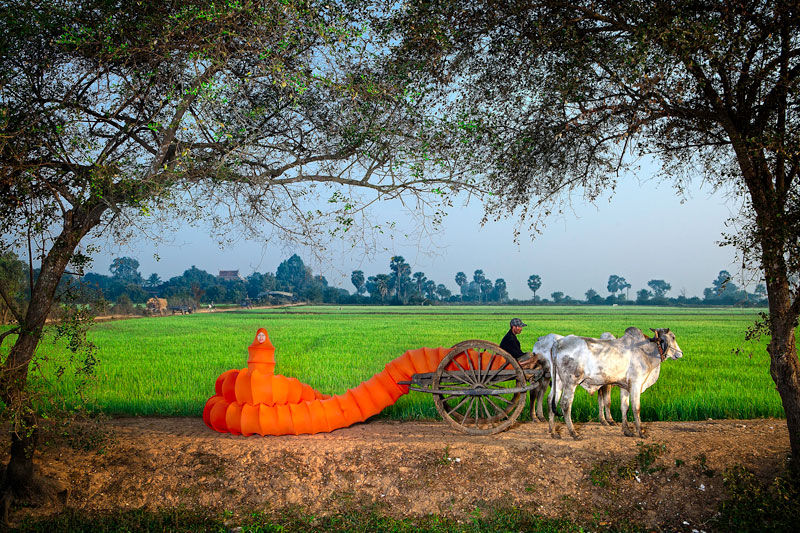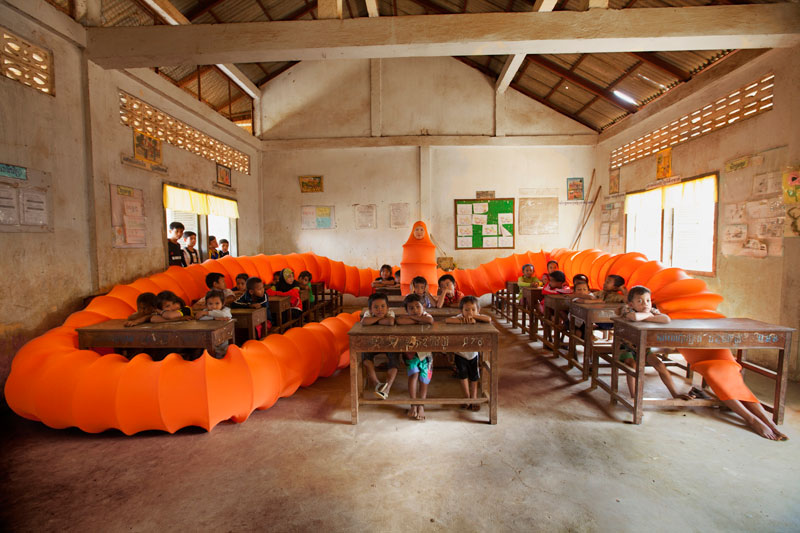You might ask, “What is that?”
But don’t expect “The Buddhist Bug” to answer.

Anida Yoeu Ali’s multimedia and performance piece is many things. It’s a caterpillar-like form sheathed in an orange shroud like a Buddhist monk. It’s a woman covered in a long Muslim hijab. It’s an odd addition to an otherwise normal scene, or it’s a natural part of the landscape.
The Bug itself is a 40-meter-long creature made of Lycra, wiring and clear tubing. But mostly, it’s a curious and obstinately orange question mark.
“The Buddhist Bug,” in more common terms, is Ms. Yoeu Ali’s upcoming exhibition of images, videos and performance, which opens at The 1961 gallery in Siem Reap on Sunday and runs until January 20.
“What is she, who is she, why is she in this setting, and does she belong?” Ms. Yoeu Ali asked in a recent interview. “These are the questions that I’m trying to get the viewers to ask themselves.”
And, by encouraging villagers to participate in producing this project, Ms. Yoeu Ali brings a rare discussion on contemporary art to the countryside.
The exhibition, curated by Dana Langlois, includes a sculptural installation of the Bug suit, new photographs and videos of the Bug interacting with various environments, as well as a live performance of the Bug during the exhibit opening.
This is the Bug’s second appearance in Cambodia, after Ms. Yoeu Ali’s first exhibition in Phnom Penh in 2013, where she showed images of the Bug bemused in different areas of the capital city.
This upcoming iteration of the Bug, however, brings Ms. Yoeu Ali back to her birthplace in Battambang province, a small Muslim enclave in Dum Spey village.
Among concepts behind the Bug’s inception is diaspora: The artist was born in 1974, moved to the U.S. as a child, grew up in Chicago and attended the School of the Art Institute of Chicago. After 30 years, she returned to work in Phnom Penh as part of a U.S. Fulbright Fellowship she won in 2011. She’s now based in Phnom Penh as a collaborative partner at Studio Revolt, an independent artist-run media lab.
In that way, the Bug is somewhat autobiographical—even in its form.
“I’m exploring a diasporic being, a being that for me has to be able to stretch as if she could be a bridge or a tunnel, connecting one place to another,” Ms. Yoeu Ali said. “Or that she could collapse and coil into something really small and compact.”
“It really speaks about, for me, the diasporic dilemma of the person such as myself who is in that state of flux, constantly insider or outsider, going in between those two identities, and at the same time not having one place to call home or one community of affinity where you belong,” she said.

Also drawing on her life, the Bug amalgamates Buddhist and Muslim influences on Cambodian culture in one mutually constitutive body, a resounding theme for Ms. Yoeu Ali, who’s a Cham Muslim.
She said she was inspired by monks’ vibrant saffron robes. But the Bug is also a form of hijab, the Muslim covering for women, which Ms. Yoeu Ali says is in line with the teachings of Prophet Muhammad.
“In my opinion, she follows exactly what the hadiths say: She should be fully covered except for her face and her hands and feet,” she said, pausing. “Well, she doesn’t have hands.”
Reformulating religious aesthetics, Ms. Yoeu Ali’s hybrid creation transcends those iconographies. But it’s certainly not without some fun.
“Obviously, part of this is humor,” she said.
In her live performances, as recorded in the videos, Ms. Yoeu Ali embodies the Bug—with a helper acting as the Bug’s feet stretched 40 meters away. Without speaking, the bug awakens and explores the world around her, observing, moving, slowly.
“Every performance, it’s as if she’s been transported and she’s opening her eyes for the first time,” Ms. Yoeu Ali said.
But it’s also about the people around her.
“There’s something very magical that happens and it has everything to do with the suspension of disbelief,” she said. “They’re in the world, with the bug.”
Indeed, more than an artwork, the Bug is itself a commentary on the state of contemporary art in Cambodia—and how people respond to it.
“This is a performance, so there’s always people around and people are encouraged to engage very naturally,” she said.
This interaction is intrinsic in Ms. Yoeu Ali’s approach from the start. Each photo or video shoot in a village takes about half a day, though it takes Ms. Yoeu Ali and her team of photographer, videographer and assistants a day or two-—some times longer—to scout.
It becomes a communal affair, drawing villagers young and old, eager to behold the Bug. And while meeting people, Ms. Yoeu Ali begins a conversation about art.
“It’s more interesting when you are able to engage in the discourse of contemporary art with locals who have never been exposed to it. This was a very strange project for many of the people in this village,” she said.
“But this is, I think, part of the work of the contemporary artist, especially in Cambodia, where all of this is very new and foreign to people.”
Ms. Yoeu Ali has performed the Bug in galleries around the world, most recently this year in Fukuoka, Japan, and in Singapore. But it’s here in Cambodia that Ms. Yoeu Ali feels her work has the most impact.
“We all know critical thinking is not heavily impressed upon in this education system, and so people have to get it from other means,” she said. “I think art can be a vehicle.”
So how have those interactions gone in the rural communities?
“It’s all different kinds of reactions,” Ms. Yoeu Ali said. “They always call it strange.”
But strangeness, the movement artist said, is the point.
“I try to pose the question back on people when they ask me: ‘What is this about?’ and just say: ‘Well, what do you think it’s about? Do you think it’s weird? Why do you think it’s weird? Why do you think she’s dressed in orange? Or why do you think her body is like that?’”
As the Bug crawls along, Ms. Yoeu Ali hopes to push discussions beyond galleries and into grassroots communities.
“To me, this is the moment that I’m interested in,” she said. “This is the moment of engagement where the entire community comes out just to see what we’re doing. That’s how curious people are of what’s going on and what this thing called art is.”
Ms. Yoeu Ali’s exhibition at The 1961 comes in the middle of a world tour for “The Buddhist Bug,” including exhibitions in France and Australia next year.
But though the Bug—diasporic as it is—will continue to travel, Cambodia holds a special place for both the creature and the artist.
“Whether performance art is a vocabulary that is understood here or not, it doesn’t matter to me,” Ms. Yoeu Ali said. “For me, as long as there is a space to have a conversation that requires more than one person, then I think that’s an important space to occupy as an artist.”



